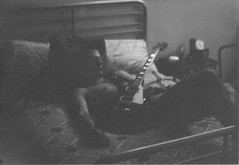Invention Disclosure
Described herein is concept for a novel model for pseudo-simulation ("MODEL") of social or other interpersonal interactions among a plurality of persons. INVENTOR claims ownership of implementation of MODEL in all softwares and in hardware devices whose principal function is to run such a model. Possible applications of MODEL include, but are not limited to:
- Entertainment - use in "role-play" and other games
- Research - use in research in such fields as psychology and sociology
- Training - use in various training exercises in which the trainee must react to decisions ranging from rational to irrational.
Details:
...continuedThe disclosed MODEL is a probabilistic, time-variant system with linear characteristic and non-gaussian deviation. MODEL requires three inputs: HistoryFact, HistoryPerception, and CurrentState. Further, MODEL provides three outputs: Decision, Value, and Confidence. MODEL processes the inputs using weights with default values that place highest consideration on CurrentState, followed by HistoryFact, and lowest weight on HistoryPerception. Custom weights may be defined for a given simulation, but generally the default weight scheme holds. MODEL first creates a list of possible Decisions, then attempts to select the Decision that provides the highest Value. Value is assessed on a exponential-decaying curve, with Value points most heavily weighted on the subject of the model and decaying by "degrees of separation" in relationship from the subject, as defined in HistoryFact. For example, a label of "immediate family" or "close friend" has a higher Value weight than "new acquaintance," "stranger," or "adversary." Additionally, the HistoryPerception input affects the Value judgement of MODEL. However, unlike HistoryFact, items in HistoryPerception do not have a one-to-one relationship with items in Value; rather, HistoryPerception is characterized by nonlinear error. What differentiates this MODEL from other social models is that many other social models use a Gaussian distribution of error to propagate items in inputs similar to HistoryPerception, whereas MODEL uses a "black box" or "neural network" method of error propagation. Hence, errors in HistoryPerception are not readily described by standard probabilistic means, nor do they show strong correlation with "rational" decisionmaking that would be based on CurrentState. Instead, errors fall somewhere between these two well-understood models.
After all possible Decisions have been analyzed, MODEL outputs the Decision that has the highest Value. Recall that Value is based on relationships defined in HistoryFact and on situations defined in HistoryPerception and CurrentState. Confidence of the result indicates how strongly the subject will defend Decision: low levels of Confidence mean that the subject may deviate from Decision with minimal pressure. Confidence level increases linearly with Value and decreases cubically with reliance upon HistoryPerception.
Example: MODEL was run with subject and two other persons: A has a short but rich history with subject, and B has very little history with subject. For both A and B there is heavy reliance on HistoryPerception, which, recall, has nonlinear error. In three distinct trials of slight variations on this setup, subject has acted consistently with MODEL's prediction, despite low Confidence and moderate Value. Confidence was indeed a good indicator of subject's adherence (or lack thereof) to Decision. Of note, however, is that MODEL provides no provisions for subject to "learn;" in other words, similar classes of inputs with different individual persons do not yield progressively higher Value or higher Confidence. Future Work: INVENTOR seeks a programmer or another inventor who can add such a learning feature to MODEL. Further studies of MODEL's applicability on several subjects in various situations will likely reveal more factors that must be adjusted.



 Gears and Coffee
Gears and Coffee
0 Comments:
What do you think?
<< Home